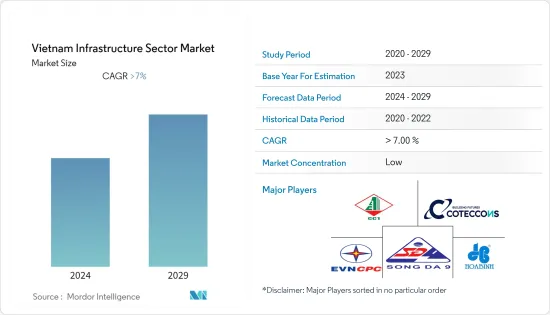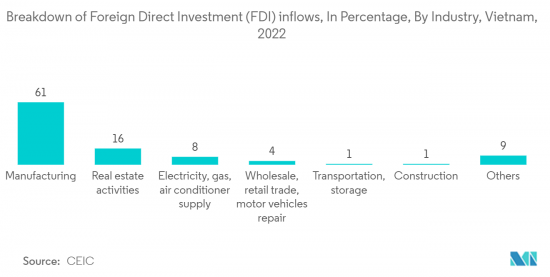PUBLISHER: Mordor Intelligence | PRODUCT CODE: 1403923

PUBLISHER: Mordor Intelligence | PRODUCT CODE: 1403923
Vietnam Infrastructure Sector - Market Share Analysis, Industry Trends & Statistics, Growth Forecasts 2024 - 2029

The Vietnam Infrastructure Sector Market size is estimated at USD 18.33 billion in 2024 and is expected to reach USD 26.11 billion by 2029, growing at a CAGR of 7% during the forecast period.
Key Highlights
- Vietnam presently invests 6% of its GDP on infrastructure, whereas the rest of the region spends an average of 2.3 percent, making Vietnam the ASEAN leader in infrastructure investment. However, analysts believe that there is a disconnect between Vietnam's present infrastructure and its ambitions to be a fast-growing economy. Vietnam Briefing discusses significant infrastructure, present prospects, and government efforts in Vietnam. As per the Global Infrastructure Hub, Vietnam needs on average USD 25-30 billion annually for infrastructure if the country wants to ensure economic growth. However, the national budget can only allow for USD 15-18 billion (at 7 percent of GDP). Therefore, the country has to source the remaining USD 10-15 billion from private investors.
- Government plans to develop further infrastructure, with power and toll roads likely to be the main areas for expansion and quality improvements. Other infrastructure, including ports and railways, will also be developed. It is backed by the government's emphasis on developing the country's rail, road, and energy infrastructure, as well as funding for the building of affordable housing. The government's plan to build 1.4 million units of social housing in Hanoi, Ho Chi Minh City, Da Nang, Can Tho, and Hai Phong Cities by 2030 would also promote forecast-period development in the business. In addition, four state-owned banks put aside VND120 trillion (USD 5 billion) in loans in February 2023 to promote the construction of social housing and worker housing projects.
- Infrastructure has been a central factor in Vietnam's fast-paced economic development. However, economic growth is putting increasing pressure on Vietnam's infrastructure. Freight volumes are expanding rapidly. Road traffic has increased by an astounding 11% annually and the demand for energy is expected to grow by about 10% per year until 2030.
Vietnam Infrastructure Market Trends
Foreign Direct Investment (FDI) Boosting the Vietnam Market
Vietnam is expected to receive 36-38 billion USD in foreign direct investment (FDI) in 2023, according to the Foreign Investment Agency under the Ministry of Planning and Investment (MPI). In 2022, the number reached about 22.4 billion USD. The opening of China's economy may have an impact on Vietnam's foreign investment attractiveness, with China being the area's largest investment destination, so when they open up, money will flow into this market, while capital to Vietnam and other economies in the region will be constrained. On the contrary, the Republic of Korea (RoK), Japan, and Taiwan (China) will increase their investment capital flow. This trend will continue until 2025 when Vietnam will be a preferred investment location for foreign investors.
Currently, the Republic of Korea, Japan, and Taiwan (China) are Vietnam's primary foreign investment sources, and they have steadily grown their investments in Southeast Asian nations. According to the FIA, crucial criteria for FDI to continue to thrive in 2023 are economic growth outcomes in 2022 and government initiatives to improve the business investment environment, build confidence with investors, and successfully use the benefits of free trade agreements. Nguyen Chi Dung, Minister of Planning and Investment, stated that Vietnam has taken a targeted approach to obtaining foreign investment inflows that will help the country achieve its sustainable development policy.

Demand for Road Infrastructure fueling the market
By 2030, the Prime Minister has decided to work for and create a synchronized road network with certain high-quality projects, in order to steadily minimize traffic accidents and pollution. These all help to propel Vietnam forward as a developed country with contemporary industries and above-average revenue. In terms of infrastructure, the MOT aims to build a motorway network that connects important economic and political centers, as well as significant economic zones, international seaports, and airports. It also aspires to develop and update the quality of the road system, particularly national highways and integrated routes that connect to important transport hubs (internal waterway ports, airports, and railway stations) that are not linked to the parallel motorway network.
According to the approval of the PM, key national projects and priority projects of investment for the period of 2021-2030 comprise the following: i. Eastern North-South Expressway from Lang Son to Ca Mau with 2.063km in length; inter-local expressway lines; linking among Northern regions, the Central region with Central Highlands, and Southeast region with the Mekong Delta; ii. Ring roads (beltways) and linking routes of Ha Noi Capital and Ho Chi Minh City; iii. Substantial National Roads (Highways) with international or inter-regional connection.
A series of new transport infrastructure projects are now getting underway in Vietnam's Ho Chi Minh City. In all, 13 key traffic projects are being carried out, having been planned by the Ho Chi Minh City (HCMC) management board for traffic projects, The works are worth a total of USD 150 million. As one of the fastest-growing economies in ASEAN, Vietnam has a seemingly endless wish list for infrastructure. The rising population in major cities in recent years has strained and exceeded the capacity of the existing connectivity networks and utility systems. With 50% of Vietnam's population expected to be living in cities, Hanoi and Ho Chi Minh are building rapid transit systems exceeding USD 22 billion in the hope of reducing private vehicle ownership and improving air quality.
Vietnam Infrastructure Industry Overview
The market is fragmented, as many new entrants focus on bagging projects to strengthen their positions among the market's key players and are expected to grow during the forecast period due to private and venture capital investment.
Key players in the market are Central Power Corporation, Coteccons Construction, Hoa Binh Construction Group, Construction Corporation No.1, and Song Da Corporation.
Additional Benefits:
- The market estimate (ME) sheet in Excel format
- 3 months of analyst support
TABLE OF CONTENTS
1 INTRODUCTION
- 1.1 Study Deliverables
- 1.2 Study Assumptions
- 1.3 Scope of the Study
2 RESEARCH METHODOLOGY
3 EXECUTIVE SUMMARY
4 MARKET DYNAMICS
- 4.1 Market Overview
- 4.2 Market Drivers
- 4.2.1 Increase in FDI in Vietnam boosting the market
- 4.2.2 Government has focused on developing infrastructure to underpin socio-economic development strategies
- 4.3 Market Restraints
- 4.3.1 The infrastructure sector in Vietnam is fragmented, which can affect its growth
- 4.3.2 Weak global demand can pose a challenge to the growth of Vietnam's construction industry
- 4.4 Market Opportunities
- 4.4.1 With its economy growing strongly, Vietnam's need for infrastructure is increasing across a wide range of sectors
- 4.5 Value Chain / Supply Chain Analysis
- 4.6 Porter's Five Force Analysis
- 4.6.1 Threat of New Entrants
- 4.6.2 Bargaining Power of Buyers/Consumers
- 4.6.3 Bargaining Power of Suppliers
- 4.6.4 Threat of Substitute Products
- 4.6.5 Intensity of Competitive Rivalry
- 4.7 Market Insights
- 4.7.1 Current Economic and Construction Market Scenario
- 4.7.2 Technological Innovations in the industry
- 4.7.3 Impact of Government Regulations and Initiatives on the Industry
- 4.7.4 Impact of COVID -19 on the market
5 MARKET SEGMENTATION
- 5.1 By Infrastructure segment
- 5.1.1 Social Infrastructure
- 5.1.1.1 Schools
- 5.1.1.2 Hospitals
- 5.1.1.3 Defence
- 5.1.1.4 Others
- 5.1.2 Transportation Infrastructure
- 5.1.2.1 Railways
- 5.1.2.2 Roadways
- 5.1.2.3 Airports
- 5.1.2.4 Waterways
- 5.1.3 Extraction Infrastructure
- 5.1.3.1 Power Generation
- 5.1.3.2 Electricity Transmission & Disribution
- 5.1.3.3 Water
- 5.1.3.4 Gas
- 5.1.3.5 Telecoms
- 5.1.4 Manufacturing Infrastructure
- 5.1.4.1 Metal and Ore Production
- 5.1.4.2 Petroleum Refining
- 5.1.4.3 Chemical Manufacturing
- 5.1.4.4 Industrial Parks and clusters
- 5.1.4.5 Others
- 5.1.1 Social Infrastructure
6 INFRASTRUCTURE SECTOR IN VIETNAM - INVESTMENT ANALYSIS
7 COMPETITIVE LANDSCAPE
- 7.1 Overview (Market Concentration and Major Players)
- 7.2 Company Profiles
- 7.2.1 Central power corporation
- 7.2.2 Coteccons construction joint stock company
- 7.2.3 Hoa binh construction group joint stock company
- 7.2.4 Civil engineering construction corporation no1 - jsc
- 7.2.5 Song da corporation - jsc
- 7.2.6 Nam long investment corporation
- 7.2.7 Vietnam expressway corporation
- 7.2.8 Minh duc concrete and construction company limited
- 7.2.9 Fecon corporation
- 7.2.10 Cofico construction
8 MARKET OPPORTUNITIES AND FUTURE TRENDS
9 APPENDIX




